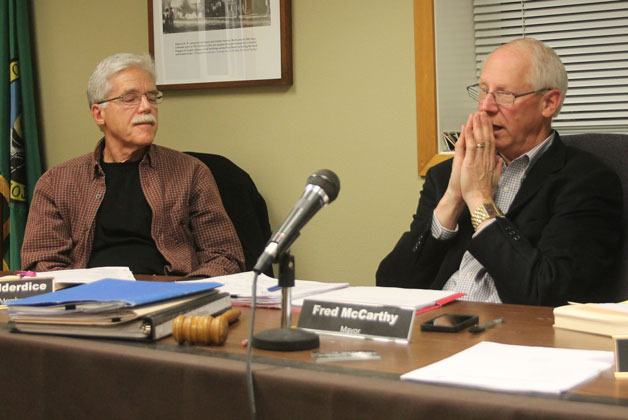The Langley City Council unanimously agreed on one thing Monday night: implementing state required sewer and water regulations is a lot less burdensome for counties than for cities.
Maria Cablao, Langley’s Public Works director, presented a glum estimate of her department’s finances in the sewer and stormwater funds. Langley’s sewer fund is expected to face a $200,000 shortfall in the coming year between its expenses, estimated around $470,000, and its revenue of about $270,000.
“This revenue has been less than the expenses for not just this year, and it’s going even further south,” Cablao said.
The shortfall is due to increased regulations and restrictions, which has translated to greater expense, and because the 1992-built treatment plant was designed for 1,600 hookups and it’s currently only serving 900.
As Langley works on its 2014 budget, how the city will cover that major gap in funding is up in the air. Cablao proposed increases between 3 and 5 percent for the sewer rates and 3 percent for the stormwater fund.
Last week, the proposal was for up to 6 percent for sewer rates, but it was reduced to just 5 percent in the draft budget presented Monday.
Currently, a single family residence inside city limits pays a fixed, bi-monthly rate of $83.86 for up to 8,000 gallons for water. Sewer costs $53 per month, up to 3,750 gallons. Stormwater rates are $48. That amounts to $184.86 every other month for water, sewer and stormwater utilities for the average Langley resident.
Water rates are not likely to rise, as Cablao did not recommend an increase. Sewer, with at most a 5 percent hike, would cost $55.65 on the bi-monthly bill. Stormwater, with the recommended 3 percent hike, would cost $49.44. For a single family residence, that’s an additional $34.54 per year.
“I know that we have to be sensitive to our citizens and residents and the economic hardships that they’re under,” Cablao said.
She noted that the sewer fund’s revenue stems from three “streams,” growth, connections and utilities rates. With little new construction in Langley, she said the city was limited in its options to cover the sewer fund’s revenue.
“The only opportunity to address this challenge, this shortfall, is rate structure,” Cablao said.
When Langley built its sewer treatment plant in 1992, the city was projected to have 1,600 homes hooked up to the sewer line. About 900 are on the line today, well short of the plant’s full capacity.
Councilman Hal Seligson proposed enticing homes in Langley that use a septic tank to connect to the sewer line. It’s not a new idea, but it would behoove the city to look at the issue again, he said.
“Not only is it good for the business end of running a sewer system, but also, ecologically, the responsible thing is to get people away from septic systems, especially in critical areas,” Seligson said.
The city council widely grumbled about the disadvantages Langley has in its utilities rates compared to Island County. Because Langley is an incorporated area, it has to meet specific measurements for its utilities quality, such as daily testing of its water quality and other oversight. Langley’s leaders acknowledged that when rural county residents compare their rates to Langley residents, the differences seem stark.
“As a municipality, we have a lot of rules and regulations that we have to abide by,” said Debbie Mahler, Langley’s treasurer and clerk. “We have the same regulations as Seattle.”



